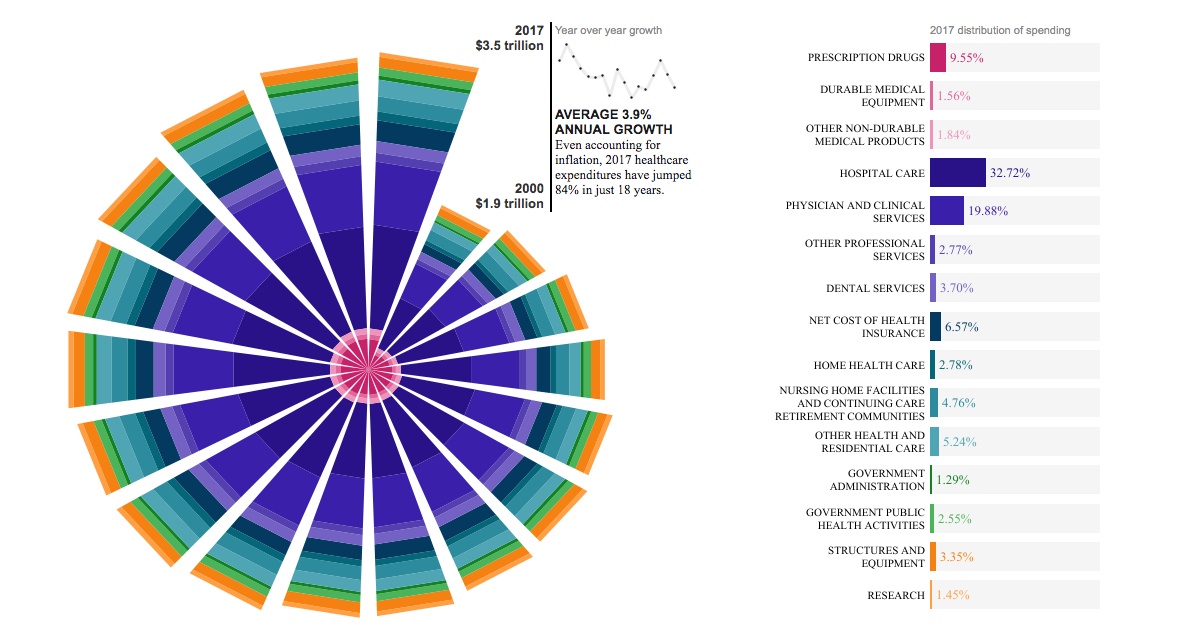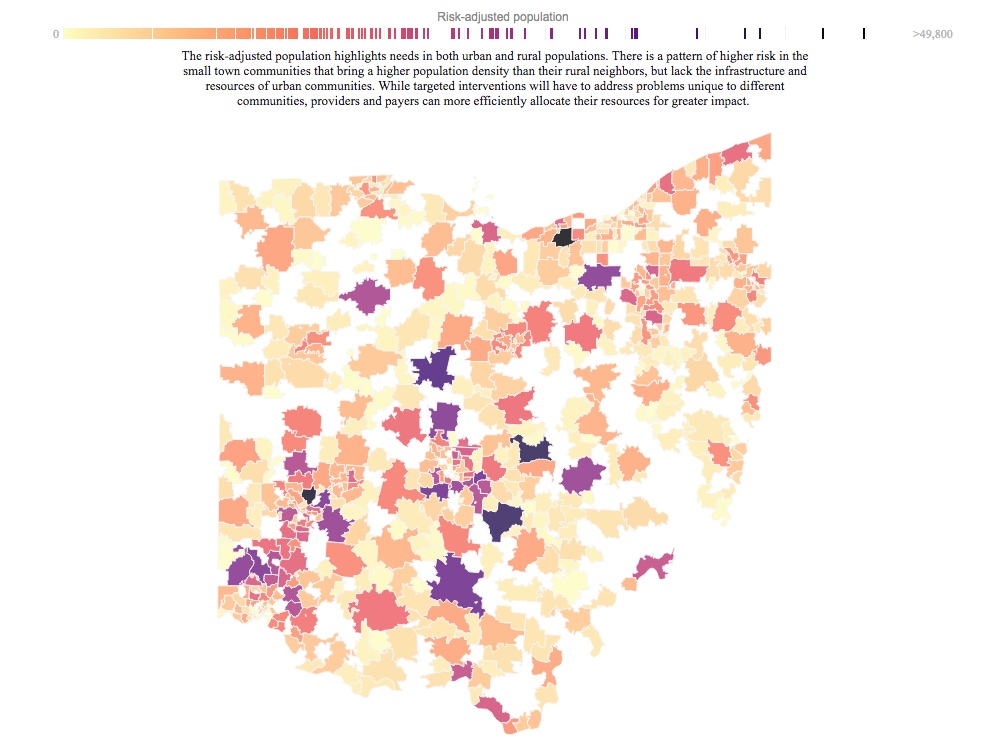
Front Health improves clinical quality, patient health and total cost of care with Tableau
Supported population health initiatives for more than 500,000 patients
Achieved internal annual operational savings of over $1,000,000
Decreased client per member per month spending trend by 3 percent
Front Health was born out of Midwest Health Collaborative (MHC), a consortium of Ohio-based health systems, to offer data-driven clinical transformation capabilities that help providers and payers succeed in value-based care. Front Health has a goal of creating and sharing analytics that will help lower the total cost of care and improve the health of patients. To date, automated, on-demand analytics through Tableau have helped health systems manage patient quality and cost across 45 hospitals, 1,900 care sites, 17,000 multi-specialty providers and more than 500,000 patients.
Front Health began by providing valuable ad-hoc analyses from financial and clinical data to health systems. In order to scale their work and provide more insights to more users, Front Health adopted Tableau as its embedded analytics platform. The organisation paired clinical expertise with data-driven insights to create maximum value for health systems. Appplying user-driven design to the development of a holistic suite of resources, Front Health provided a one-stop shop for value-based care insights, which are useful to many different stakeholders.
Users encompass the entire spectrum of provider roles – from clinical and financial executives creating revenue-maximising strategies, to physicians and care managers executing those strategies through patient interaction. Tableau has assisted in generating more than $1,000,000 in annual operation savings for Front Health by automating manual efforts and expanding resource bandwidth. Using Tableau, Front Health has deepened provider engagement across a number of population health initiatives. With data-driven insights in hand, providers now make decisions that boost contract performance, decrease per member per month spending trends, and improve patient quality and key contract metrics.
Front Health has also extended its user-focused design process to its consultancy and more public-facing work, showcasing dashboards through Tableau Public.

Excerpt from Front Health’s dashboard “The Real Growth of US Healthcare Spending, 2000 – 2017”.
User-driven design increases analytics adoption
Front Health consultants previously accessed clinical and claims information manually, performing data preparation and analysis in Excel and delivering results to health systems in PowerPoint. “This delivery method wasn’t streamlined for users or Front Health,” explained Joshua Smith, Creative Director, Analytics at Front Health.
Front Health employed a user-driven approach as it created several analytics products and two philosophies influenced their deployment: understanding users and their decision-making, and joint ideation and development. The analytics team wanted the end product to be part of the user’s existing workflow and to offer an intuitive interface that combines data and insights, making it easier for them to act on the insights. Josh and his team took these steps to understand users’ goals, obstacles and the action space – meaning the levers they can pull to achieve their goals – and involved them in the dashboard design process. This included:
- Conducting social research, looking at LinkedIn profiles, job postings and CVs to understand qualities and requirements that align with positions at health systems.
- Looking at common statistics and visualisations included in previous reports.
- Holding interviews as they created a library of user personas.
- Developing a decision-making map to see how information was used by providers when making decisions.
- Inviting users to wireframe whiteboarding sessions and collecting feedback before finalising dashboard designs.
As Josh explained, “There’s this beautiful back and forth where we learn more about them, their business and their pain points. But they also learn from us, and what the trade-offs are for each visual.” One design session even involved a stakeholder jumping in with a marker and creating their own wireframes, and having that level of engagement “is an eye-opening moment as a designer”. To that end, Tableau’s flexibility to pull from different data sources and mould to health systems’ different needs – whether the user is a clinician or experienced analyst – resulted in a streamlined data analytics product with an intuitive framework.
Adoption has been awesome. We had one user who literally danced when she accessed the dashboard… We helped her put words, ideas and drawings to life in Tableau that meet her needs.
Automated dashboards assess care and health system performance, resulting in ~$1M annual savings
With Tableau-driven reporting, Front Health now provides clients with the key clinical and claims data they need to make valuable decisions. The three key areas analysed and reflected in different Tableau dashboards are total cost of care, quality and risk adjustment, and care management. Explanations for these dashboards, and the use cases they solve for include:
- Performance improvement – Executives can quickly uncover opportunities and strategise interventions in high-spend areas by looking at per member per month spend and drivers of trends.
- Quality and risk adjustment – Finance and clinical executives see their performance versus quality metrics across different contracts, so they can maximise treatment quality and conduct targeted patient outreach.
- Care management – Executives can better decide if they should expand care programmes to other populations through the combination of predictive analytics and statistical modelling paired with care management performance data. Care managers can better assess the efficiency of their operations, bringing stronger impact to more managed patients.
Front Health will soon grow its dashboard collection to include physician, pharmacy and chronic condition scorecards, performance benchmarking and social determinants intervention. This will enhance the value Front Health delivers clients and support clinical and system performance improvements that make the goals of lower cost and better quality of care attainable for providers and the patients they treat.
To really align the product – the end result – with what the end users needed, Tableau was the only thing that would offer the flexibility we were looking for.
Embedded Tableau analytics enhance performance of clinicians
Reports and dashboards that require the users to exit their natural workflows for a manual and isolated experience is disruptive to executives and providers. It removes them from the moment where they should focus on important strategic and tactical decisions and requires them to spend energy and time thinking about how the data analytics product works.
All Tableau-powered dashboards that Front Health manages and provides clients through its comprehensive consulting services are organised in an architecture that aligns with the decision map it collected. This ensures users intuitively follow a workflow aligned with their needs. That framework is mapped along strategic versus tactical and clinical versus financial axes, and each dashboard has its own distinct spot and purpose; this guarantees updates and new dashboards fit within a holistic framework and users aren’t overwhelmed with hastily developed analytics. Furthermore, it provides users with a streamlined workflow and serves as a map for access rights.

Front Health’s solution architecture helps map dashboards to strategic and tactical decision-making within end-user workflows.
“Each dashboard provides those crumbs, like Hansel and Gretel going through the forest – all of them providing steps that get you to those final questions and answers that move you closer to areas of opportunity,” said Joshua. And Front Health has seen the impact that automated analytics in Tableau created in supporting population health initiatives for more than 500,000 patients.
Collaboration in developing dashboards and the improved user experience collectively created deeper engagements with Front Health clients. This is apparent in positive user feedback, where they express excitement in seeing areas of waste for their health system, what triggers it and how they can analyse evidence-based measures to help get rid of it.
Tableau influences Front Health’s analytics roadmap and operational efficiencies
Seeing Tableau’s value in powering the Front Health analytics platform to lower total cost of care and improve patient health, the organisation is now applying analytics internally and externally to other key areas. It’s also using Tableau Prep and seeing significant organisational efficiencies. Before, complicated data management was handled by data engineers who juggled too much work. But now, anyone performing analysis can do most data prep work themselves, which frees up data engineers to do more strategic work and allows analysts to be more innovative.
Front Health is also elevating its consultancy work with its successful design strategy process and framework to help clients maximise their Tableau value. Front Health brings a creative, user-focused path that pairs clients’ IT and business strategies for easily interpreted, user-friendly analytics.

Excerpt from Front Health’s dashboard "The Health Risk of Where You Live, Ohio, 2017".
Some of the company’s work is showcased in a collection of dashboards on Tableau Public. Front Health has seen strong reception and enhanced credibility through its Tableau Public portfolio, and even won Visualisation of the Day with The Health Risk of Where You Live. It covers a wide spectrum of analytics – machine learning, predictive analytics and data sourcing – as Front Health shines light on a topic with global impact. Plus, using a simple design made complex data about social determinants of health easier to understand.